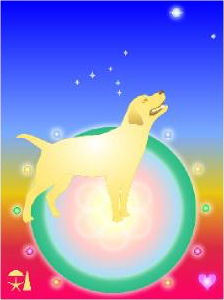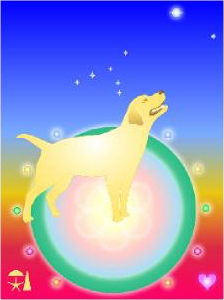
I’ve had animal companions all my life, and it has always brought a deeper sense of joy into my world. After the loss of my beloved collie at the age of 10, I never wanted to make that leap and get a dog again. I’ve had wonderful cats and precious parrots but no dog.
A little over a year ago, we welcomed a mix breed rescue into our lives, and our world hasn’t been the same. What a great gift!
The thing about dogs is that they love you unconditionally and to the maximum level allowed anywhere short of Heaven. Of course, other animals can extend that same degree of love, but few are so demonstrative of it. Our dog teaches us daily how to love. She never holds back. She shares without reservation under all sorts of conditions.
One of the most striking things about her love is the complete happiness she reveals each time she greets us anew. Whether we’ve been gone to the post office for 10 minutes or have been out for much of the day, the same amount of love is lavished on us, and the joy she shows is undeniable and immense. She jumps into our arms (whether we’re ready or not) and offers as many kisses and hugs as we will tolerate.
When I mentioned this to someone, the person suggested it might be because dogs live so much shorter a life span than we humans, and every minute seems like forever to them as a result. I expect there is some truth to this. But what I know for sure is that she simply wants to be in our presence, constantly streaming her love to us. That love is almost more than she seems able to contain, and it must be expressed and emitted.
What if we loved like that? What if we greeted each other with so much joy from our hearts at meeting our kindred? What if we could hardly contain the love we held and felt we might burst if we didn’t share it?
What a way to live that would be. If we felt and shared half as much love and joy as a dog, we could make the world a place of wonder and grace for everyone and everything. So I decided I’m going to try that. Tonight when my husband comes home from his conference, I’m going to greet him as if he were the most important person in my life. I’m going to kiss him and hug him and tell him I love him. I’d love to make him feel as welcomed home as our pup does.
Will I succeed? Well, I’m not as unconditionally loving as our dog, but I do have a great deal of love in my heart, so why not let it flow?
Will you join me in working toward sending joy and love to those dear to you? I suspect it will change our lives and the lives of those we touch, and maybe, just maybe, it will ripple out into the world in an ongoing flood of love enough to fill the planet.
Here’s to living as lovingly as a dog and to the ultimate happy to see you!

 I continue to learn from our dog. After over five decades without a canine companion, I’m remembering how marvelous they are in so many ways. What I see above all is their ability as empaths. They don’t shy away from being empathic. They lean into it. They give everything without a thought for holding back.
I continue to learn from our dog. After over five decades without a canine companion, I’m remembering how marvelous they are in so many ways. What I see above all is their ability as empaths. They don’t shy away from being empathic. They lean into it. They give everything without a thought for holding back. For the first time since childhood, I welcomed a wonderful dog into my life. Our precious collie Laddie died after being run over by a car when I was 10. When I saw the face of this beautiful dog who now shares our lives, I knew I had to save her. She was in a kill shelter just one day away from being put to sleep.
For the first time since childhood, I welcomed a wonderful dog into my life. Our precious collie Laddie died after being run over by a car when I was 10. When I saw the face of this beautiful dog who now shares our lives, I knew I had to save her. She was in a kill shelter just one day away from being put to sleep.